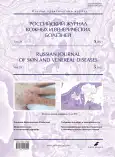Comparative study of the effectiveness of combination therapy of vitiligo with methotrexate in combination with medium-wave narrow-band therapy UVB-311 nm and monotherapy UVB-311 nm
- Authors: Tavitova A.R.1, Lomonosov K.M.1
-
Affiliations:
- I.M. Sechenov First Moscow State Medical University (Sechenov University)
- Issue: Vol 24, No 5 (2021)
- Pages: 451-459
- Section: CLINICAL PICTURE, DIAGNOSIS, AND THERAPY OF DERMATOSES
- URL: https://journals.rcsi.science/1560-9588/article/view/88864
- DOI: https://doi.org/10.17816/dv88864
- ID: 88864
Cite item
Abstract
BACKGROUND: Vitiligo, a multifactorial chronic acquired disease with a genetic predisposition, occurs due to the destruction of melanocytes of the skin and is characterized by the appearance of foci of depigmentation. Despite the fact that new therapies are emerging, there are no actual treatment regimens that would guarantee a positive result, including stopping the progression of the process, repigmentation. In this regard, it is advisable to search for drugs that have an immunosuppressive effect.
AIMS: Clinical evaluation of the effectiveness of methotrexate in combination with UVB-311 nm and UVB-311 nm monotherapy in vitiligo.
MATERIALS AND METHODS: 77 patients suffering from progressive vitiligo were included in this study. All patients were divided into 2 groups. A course of methotrexate therapy in combination with UV therapy was prescribed to 39 patients, UVB-311 nm monotherapy was performed in 38 patients. The lesion area relative to the body surface area was estimated using the VES index (Vitiligo extent score) on the vitiligo calculator. The effect of the disease on the quality of life was assessed using the Dermatology Life Quality Index (DLQI). The duration of the study was 6 months.
RESULTS: The patients included in the study were divided into two groups randomly. There were 39 patients in group I, 38 in group II. 76 out of 77 patients completed it: 1 patient was excluded due to increased hepatic transaminases during methotrexate therapy. Among patients receiving combination therapy with methotrexate in combination with medium-wave narrow-band therapy UVB-311 nm, there was a more pronounced decrease in the percentage of depigmentation relative to the body surface area. And also patients of this group demonstrated the most active positive dynamics of the Dermatology Life Quality Index than patients who received only phototherapy.
CONCLUSIONS: The study demonstrated good clinical efficacy of the drug. Small doses of methotrexate have a positive effect on the tolerability of the drug and prevent the development of side effects, which makes it possible to influence pathogenetic mechanisms for a long time, stabilizing the skin process.
Full Text
##article.viewOnOriginalSite##About the authors
Alana R. Tavitova
I.M. Sechenov First Moscow State Medical University (Sechenov University)
Author for correspondence.
Email: alatavitova@mail.ru
ORCID iD: 0000-0003-1930-0073
SPIN-code: 2113-9091
MD, Graduate Student
Russian Federation, 8 buil. 2 Trubetskaya street, Moscow, 119991Konstantin M. Lomonosov
I.M. Sechenov First Moscow State Medical University (Sechenov University)
Email: lamclinic@yandex.ru
ORCID iD: 0000-0002-4580-6193
SPIN-code: 4784-9730
MD, Dr. Sci. (Med.), Professor
Russian Federation, MoscowReferences
- Taïeb A, Picardo M. Clinical practice. Vitiligo. New Eng J Med. 2009;360(17):1788–1788. doi: 10.1056/nejmc090205
- Olisova OY, Andreeva EV. Once more about hyperpigmentation. Russ J Skin Ven Dis. 2014;(2):20–24. (In Russ).
- Olisova OYu, Vladimirova EV, Babushkin AM. The skin and the sun. Russ J Skin Ven Dis. 2012;(6):57–62. (In Russ).
- Krüger C, Schallreuter KU. A review of the worldwide prevalence of vitiligo in children/adolescents and adults. Int J Dermatol. 2012;51(10):1206–12120. doi: 10.1111/j.1365-4632.2011.05377.x
- Rakhimov US, Mukhamadieva KM, Ismatulloeva SS. Neurovegetative disorders in vitiligo pathogenesis. Avicenna’s Bulletin. 2017;19(4):550–555. (In Russ). doi: 10.25005/2074-0581-2017-19-4-550-555
- Hexsel CL, Eide MJ, Johnson CC, et al. Incidence of nonmelanoma skin cancer in a cohort of patients with vitiligo. J Am Acad Dermatol. 2009;60(6):929–933. doi: 10.1016/j.jaad.2008.09.033
- Chan ES, Cronstein BN. Methotrexate ― how does it really work? Nat Rev Rheumatol. 2010;6(3):175–178. doi: 10.1038/nrrheum.2010.5
- Haskó G, Linden J, Cronstein B, Pacher P. Adenosine receptors: therapeutic aspects for inflammatory and immune diseases. Nat Rev Drug Discov. 2008;7(9):759–770. doi: 10.1038/nrd2638
- Cronstein BN. The mechanism of action of methotrexate. Rheum Dis Clin North Am. 1997;23(4):739–755. doi: 10.1016/s0889-857x(05)70358-6
- Nasonov EL. Methotrexate: perspectives in rheumatology. Moscow: Filomatis; 2005. 200 р. (In Russ).
- Haskó G, Cronstein BN. Adenosine: an endogenous regulator of innate immunity. Trends Immunol. 2004;25(1):33–39. doi: 10.1016/j.it.2003.11.003
- Suskova VS, Pinson IY, Olisova OY. Immunopathological mechanisms of psoriasis. Clin Dermatol Venereol. 2006;4(1):68–70. (In Russ).
- Olisova OY. Teplyuk NP, Pinegin VB. Modern methodes of psoriasis treatment. Russ J Med. 2015;(9):483–486. (In Russ).
- Garza-Mayers AC, Kroshinsky D. Low-dose Methotrexate for vitiligo. J Drugs Dermatol. 2017;16(7):705–706.
- Singh H, Kumaran MS, Bains A, Parsad D. A randomized comparative study of oral corticosteroid minipulse and low-dose oral methotrexate in the treatment of unstable vitiligo. Dermatology. 2015;231(3):286–290. doi: 10.1159/000433424
- Van Geel N, Lommerts J, Bekkenk M, et al. Development and Validation of the Vitiligo Extent Score (VES): an International Collaborative Initiative. J Invest Dermatol. 2016;136(5):978–984. doi: 10.1016/j.jid.2015.12.040
Supplementary files









